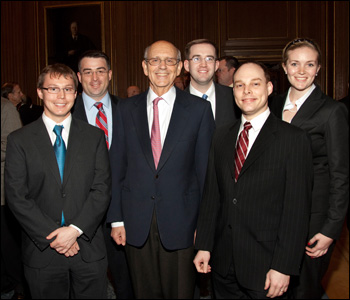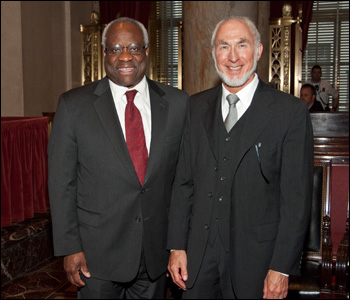PUBLIC PROGRAMS
Each year, the Society presents a series of lectures by distinguished scholars focusing on a particular period of the Court's history. These lectures are open to members of the Society, as well as to the public and are made possible by a grant from West Group, a longtime supporter of the Supreme Court Historical Society. The Society is a co-sponsor of the National Heritage Lecture, an annual event which the Society hosts on a rotating basis with the White House Historical Association and the United States Capitol Historical Society.

Justice Stephen G. Breyer and attendeees at the 2010 Leon
Silverman Lecture, March 23, 2010. Photograph by Steve Petteway.

Justice Clarence Thomas and Professor John Orth at the 2010 Leon Silverman lecture, April 27, 2010. Photograph by Steve Petteway.
ACQUISITIONS PROGRAM
The Society conducts an acquisitions program, working closely with the Court Curator's office to acquire items the Curator identifies as significant to the Court's permanent collection. It assists with commissioning of busts and portraits, purchases of period rugs and furnishings, significant photographs, documents, private papers, memorabilia and other artifacts relating to the Court's history. Many of these objects are incorporated into exhibits prepared by the Curator's office for the benefit of the Court's one million annual visitors.
EDUCATION
The Society and Street Law, Inc. offer the Supreme Court Summer Institute for secondary school teachers. The Institute improves the level of instruction on the judicial system at the secondary school level, reaching students while they are developing an awareness of their rights and duties as citizens. Teachers observe the Court in session, review actual cases under consideration, and hear lectures by experts on the Court. The teachers then produce lesson plans for classroom instruction and train other teachers in techniques for incorporating the Court into the social studies curriculum. This program has more than 750 alumni from almost every state and U.S. possession. The Society and Street Law have collaborated to bring the Supreme Court Institute to teachers around the country who might otherwise not be able to attend the Summer Program. Teachers in Atlanta, New York and St. Louis have participated in the Regional Supreme Court Seminar.
GENERAL INTEREST PUBLICATIONS
Several publications of the Society present the history of the Court in a manner suitable for students and general audiences. In cooperation with CQ Press, the Society published The Supreme Court Justices: Illustrated Biographies, 1789-1995, a collection of biographies of up to the 108th Justice (edited by Clare Cushman, CQ Press, 1995). In late 2010 a third edition of this book will bring it up to date with the addition of Chief Justice John G. Roberts, Jr., Justice Samuel A. Alito and Justice Sonia Sotomayor. Supreme Court Decisions and Women's Rights: Milestones to Equality, (edited by Clare Cushman, CQ Press, 2000) is a guide to Supreme Court cases reviewing the equal protection of men and women under the law. The Society also supported the publication of We The Students: Supreme Court Cases For and About Students (by Jamin Raskin, CQ Press, 2000) and The Supreme Court of the United States, is a pictorial history of the Supreme Court building. Although the book briefly summarizes the history of the Court (including the period before the Court moved into its permanent home in 1935), the main focus is the Supreme Court building itself, including many areas not ordinarily open to the public and seldom photographed. To mark the 50th anniversary of the Brown v. Board of Education case, Black White and Brown: The Landmark School Desegregation Case in Retrospect was published in 2004 (edited by Melvin I. Urofsky and Clare Cushman, CQ Press).
The Society publishes the Journal of Supreme Court History three times a year containing articles by noted historians, political scientists and constitutional law experts. One issue of The Journal is comprised of lectures from the Leon Silverman Lecture Series.
The Society also publishes four issues of the SCHS Quarterly newsletter annually for its membership containing short historical pieces on the Court and news about the Society's programs and activities.
SCHOLARSHIP and RESEARCH
The Documentary History of the Supreme Court, 1789-1800 was the Society's most ambitious research and historical preservation project. The reconstruction of an accurate record of the development of the federal judiciary in the formative decade between 1789 and 1800 poses many challenges since records from this period are often fragmentary, incomplete, or missing. The eighth and final volume in this series was published by Columbia University Press in April 2007.
The Society is also conducting an oral history project documenting the service of retired Supreme Court Justices, Solicitors General and Attorneys General. First-hand accounts of their careers will be preserved through recordings and the subsequent transcription and editing of oral histories. Half of the interest income generated by the $2.6 million endowment that was created from the sale of the John Marshall Silver Dollar is devoted to the support of this program.
The Society awards two cash prizes each year to encourage scholarly research about the history of the Supreme Court. The Hughes-Gossett Prize is a $1,500 prize that is awarded annually to the author of the best article published in the Journal of Supreme Court History. The Hughes-Gossett Student Prize is a $500 award for the best article submitted by a student. (Click here for information about Society Awards)
ORGANIZATION
At present, the Society has about 6,200 individual members who provide financial support and volunteer for service on its standing and ad hoc committees. These committees report to an elected Board of Trustees; the Executive Committee of the Board is principally responsible for policy decisions. The Chief Justice of the United States is the Honorary Chairman of the Society.
The Society provides financial support for the Supreme Court Fellows Program as well as staff support and serves as a fiduciary for the Supreme Court Musicale.
The Supreme Court Historical Society supports its programs through contributions from its members, gifts, grants, a small endowment gift shop. The Society is recognized as a (501) (c) (3) organization by the Internal Revenue Service.

